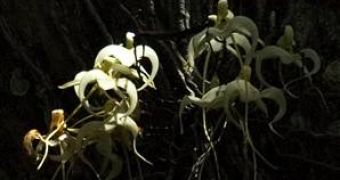This is the rarest and most mysterious orchid in the world and its vernacular name is the ghost orchid. Now, a specimen has been discovered growing high in an old cypress tree in Corkscrew Swamp Sanctuary in Naples (southwest Florida).
The Ghost Orchid (Polyrrhiza lindenii) is also called Palm Polly and White Frog Orchid and got the fame with the non-fiction book "The Orchid Thief" and the movie based on the book, "Adaptation".
The endangered epiphyte (growing on trees) flower encountered in Florida grows about 45 feet (15 m) off the ground, anchored in a network of large, tangled mass. The species inhabits moist, swampy forests in southwestern Florida, the Bahamas and Cuba.
Two bird-watchers looking for owls on Saturday spotted it about 150 feet (50 m) from the sanctuary's boardwalk and the flower can be admired only with binoculars and good lighting. This orchid blooms for about two weeks and has nine flowers, triple the normal number, but it is not known since when this orchid has been blooming.
"They're very rare, and this one is unusual because it has so many flowers. They're pretty impressive flowers, too, as big as your hand. It's nice to have it at Corkscrew. If it's here, it's safe," said photographer Ralph Arwood, who spent hours waiting to achieve a good shot of the rare blooms.
"The orchid could have been in the tree for decades. It is the first ghost orchid discovered near the sanctuary boardwalk in 12 years. It's got a big, old root mass on it. We've just never seen it before. I'm sure it's been blooming, but they bloom in June and July, and that's when cypress are leafed out. So, it's possible a cypress branch covered it up all those years and fell off in Hurricane Wilma. Who knows?" said Park Manager Ed Carlson.
As the roots of this orchid blend so well with the tree, the flower often seems like it is floating in midair, one reason for naming it "Ghost Orchid". This orchid lacks a stem and the leaves have been reduced to scales; it is made of only of flat, cord-like, green roots that absorb moisture and make photosynthesis. Pollination is accomplished by the giant sphinx moth, the only local insect with a long enough proboscis to be able to do this.
Cultivation of this rare and endangered orchid outside its habitat has been a failure.

 14 DAY TRIAL //
14 DAY TRIAL //